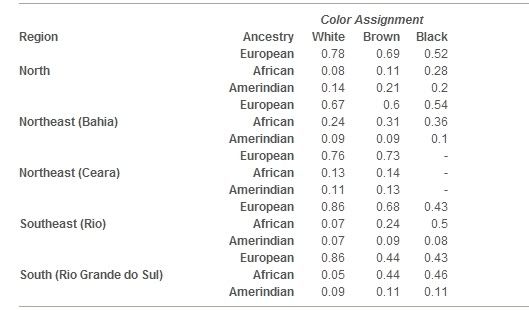| Reply to Thread New Thread |
|
|
|
|
#1 |
|
|
Having said all this, from what I have seen the concentration of pred. SSA African looking individuals is in our coastal areas where they were most used in colonial times. Rio de Janeiro, Bahia, coastal Pernambuco, mining areas of Minas Gerais, coastal areas of Maranhão are the places where they are most likely to be found. People who would score 100% SSA African would be a very small minority, probably not even 1% or 2%. Pred. SSA African individuals are more common, but they are mainly restricted to the areas I mentioned above. Overall, they are large in absolute numbers but small in % since there are many people living in Central West, North and South Brazil, which have a very small number of pred. SSA African individuals IMO, not to mention many areas in the Southeast and the Northeast where pred. SSA African individuals are not that important, like in the interior of São Paulo state. Unlike distribution of pred. SSA people, I assume more evenly mixed Pardo people (incl. amerindian mixed ones) can generally be found all over Brazil. Here's 2009 statistics from IBGE Genetically, Brazilians as a whole have European, African and Native American ancestries, all of the categories, "whites", "pardos" and "blacks". Having said that, European ancestry is still more important than any other in São Paulo state (which has ~40 million people by the way). The ancestral make-up of São Paulo state according to a genetic study from 2006: However genetical composition of average brazilians will turn out eventually it doesn't necessarily correspond with their phenotypical range. This has already been established by many genetic studies done on brazilians. Especially skin color doesn't seem to correlate much with actual african ancestral %. And of course it's phenotype (aside from socio-cultural background) and not genotype which actually determines how most people would selfidentify. And also how that country's diversity would be seen by outsiders. Not to mention it's also actual appearances and not genetical % of european admixture which determines any possible racial discrimination within society. Here's a nice table contrasting selfidentification with actual genotype. It's from this 2011 study. You can see that their sample of selfidentified " blacks" only have a maximum of 50% african ancestry, for Bahia it's even as low as 36%  , this seems to be a little bit off though to be honest... , this seems to be a little bit off though to be honest... Other source for the table and link to article on Gene Expression which has an interesting discussion about that 2011 study. Brazilians, more European than not? |
|
|
| Reply to Thread New Thread |
«
Previous Thread
|
Next Thread
»
| Currently Active Users Viewing This Thread: 1 (0 members and 1 guests) | |
|
|






 Hybrid Mode
Hybrid Mode

